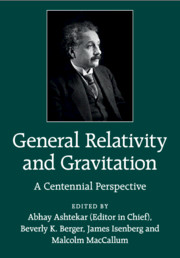Book contents
- Frontmatter
- Contents
- Preface
- List of contributors
- List of figures
- List of tables
- Part One Einstein's Triumph
- Part Two New Window on the Universe: Gravitational Waves
- Part Three Gravity is Geometry, after all
- 7 Probing Strong-Field Gravity Through Numerical Simulations
- 8 Initial Data and the Einstein Constraint Equations
- 9 Global Behavior of Solutions to Einstein's Equations
- Part Four Beyond Einstein
- Index
- References
8 - Initial Data and the Einstein Constraint Equations
from Part Three - Gravity is Geometry, after all
Published online by Cambridge University Press: 05 June 2015
- Frontmatter
- Contents
- Preface
- List of contributors
- List of figures
- List of tables
- Part One Einstein's Triumph
- Part Two New Window on the Universe: Gravitational Waves
- Part Three Gravity is Geometry, after all
- 7 Probing Strong-Field Gravity Through Numerical Simulations
- 8 Initial Data and the Einstein Constraint Equations
- 9 Global Behavior of Solutions to Einstein's Equations
- Part Four Beyond Einstein
- Index
- References
Summary
Introduction
Solutions of the Einstein equations evolve from initial data given on a three-dimensional manifold M. The initial position and velocity of the gravitational field are given by a Riemannian metric g and a symmetric (0, 2) tensor K. The metric g will be the metric induced on M as a spacelike hypersurface in the spacetime S which evolves from the data, and the tensor K will be the second fundamental form of M in S. Thus an initial data set is given by a triple (M, g, K). There is currently interest in higher-dimensional gravity in the physics community, so when convenient we will discuss initial data on an n-dimensional manifold Mn which will evolve to an (n + 1)-dimensional spacetime Sn + 1 (n ≥ 3).
A basic fact of life for the Einstein equations is that the initial data g and K cannot be freely specified, but must satisfy a system of n + 1 nonlinear partial differential equations. These are called the constraint equations, and Section 8.2 deals with recent progress on solving this set of equations. On the one hand the constraint equations present a complication in the study of the initial value problem since it is a difficult (and as yet unsolved) problem to fully analyze their solutions. On the other hand, it is because of the constraint equations that physical notions of energy and momentum can be defined. It is also because of them that geometric and topological restrictions hold in certain cases on the initial manifold M, and for black holes in Σ.
We do not have the space here to give a comprehensive survey of the initial value problem, so instead we have focused on several questions on which there has been recent progress and which are currently active areas of investigation. We have chosen to give brief outlines of the main ideas involved in the study of these specific questions rather than to attempt to touch on all aspects of the field.
- Type
- Chapter
- Information
- General Relativity and GravitationA Centennial Perspective, pp. 412 - 448Publisher: Cambridge University PressPrint publication year: 2015
References
- 7
- Cited by



